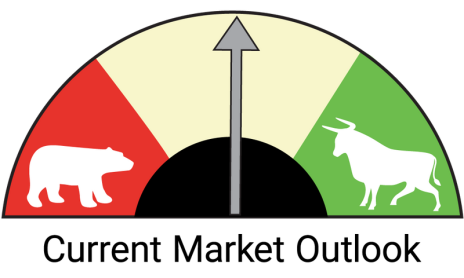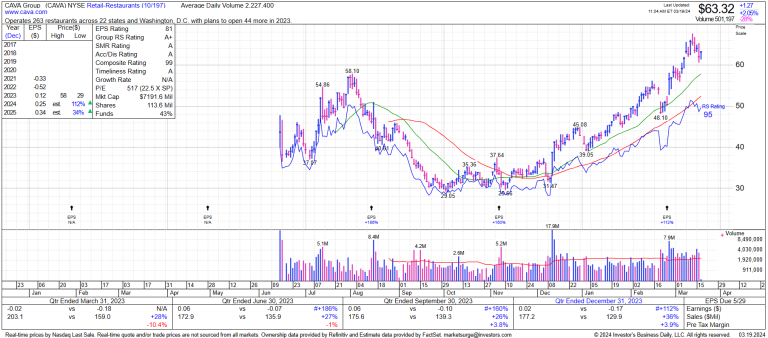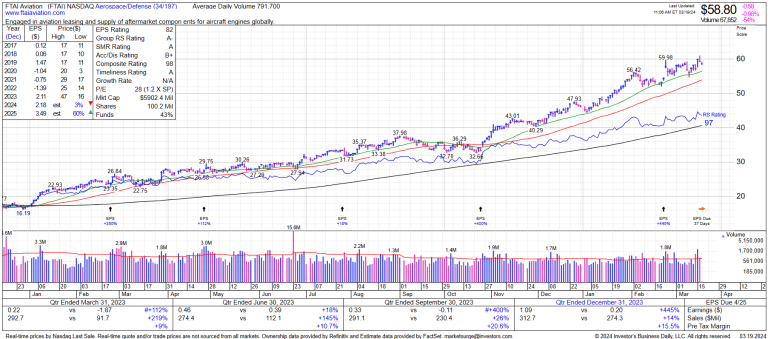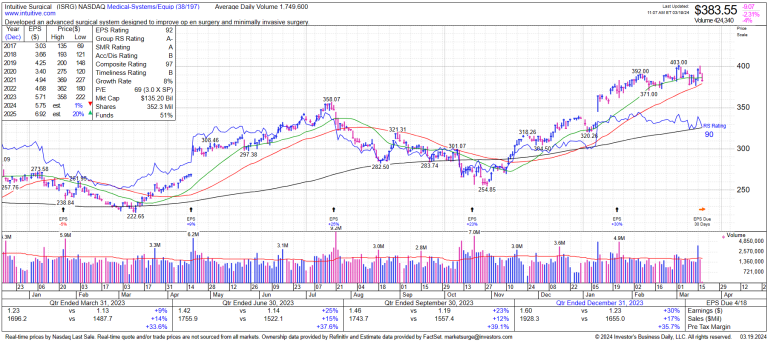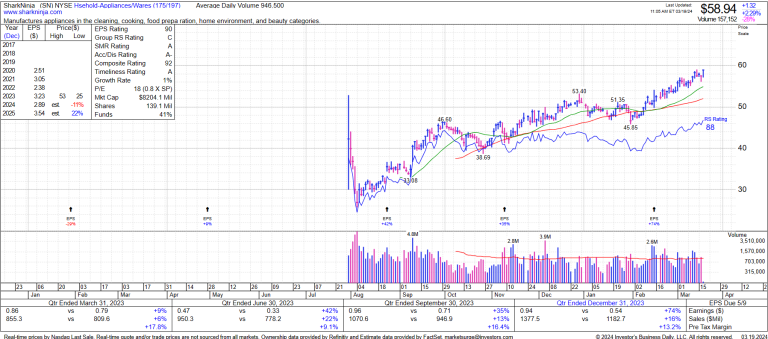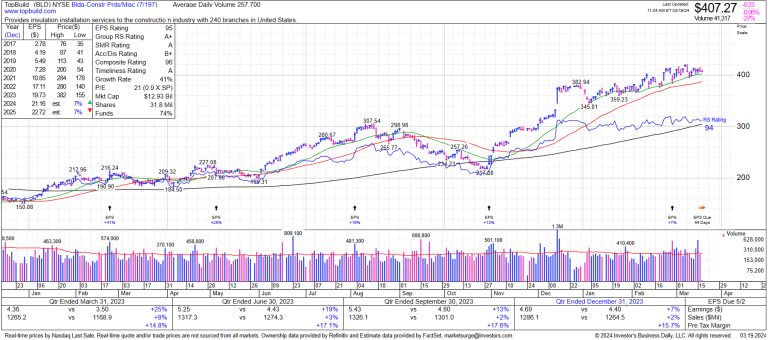Stocks in This Issue
| Stock Name | Market Cap (Fully Diluted) | Price (3/8/24) | Investment Type | Current Rating |
| CAVA Group (CAVA) | $7.01 billion | 62.3 | Growth – Fast Casual Dining | Watch |
| FTAI Aviation (FTAI) ★ Top Pick ★ | $5.87 billion | 58.5 | Growth & Value – Aviation | Buy |
| Intuitive Surgical (ISRG) | $137 billion | 388 | Growth – MedTech | Buy Half |
| SharkNinja (SN) | $8.18 billion | 58.8 | Growth - Appliances | Buy Half |
| TopBuild (BLD) | $13.0 billion | 410 | Modest Growth – Insulation | Watch |
Portfolio Updates
With earnings season behind us and a number of profitable trades locked in over the last two months, it’s time to review the remaining positions in our portfolio.
Cadre Holdings (CDRE) has been a very steady performer but shares fell last week on news of a secondary offering priced at 35. Given the solid Q4 performance and good 2024 guidance (15%+ revenue growth not factoring in acquisitions), with M&A likely (hence the secondary), I expect the stock to resume its uptrend soon. BUY
Crocs (CROX) stock continues to act well in the month after the company beat Q1 expectations. This is a self-help story with the clean-up of the HeyDude brand tracking nicely and the Crocs brand continuing to outperform. BUY
Leonardo DRS (DRS) held its first Investor Day last week with management talking about growing profit margins in the Columbia-class sub program and appetite for M&A. Results in Q4 came in better than expected and guidance for 2024 included 4% to 7% revenue growth ($2.95 - $3.03 billion) and EPS of $0.74 to $0.82. Following last week’s event, Bank of America increased their target price from 22 to 26. BUY
Microsoft (MSFT) continues to look fantastic and hit a new high last Thursday. The latest news came out of Microsoft’s second annual Secure event, which was focused on Copilot for Security and all the ways Microsoft is going deeper into the security market with this solution. While not expected to be a major revenue driver in the immediate term, the company’s strategy to broaden AI use across its security suite is likely to drive significant revenue down the road as security analysts flock to its solutions. BUY
Netflix (NFLX) is also acting very well and shares are within a stone’s throw of the November 2021 all-time high. The company is accelerating revenue growth and free cash flow, as well as expanding margins, as it focuses on paid sharing, with advertising another likely tailwind over time. Netflix is moving toward becoming the world’s default streaming service provider. BUY HALF
Rivian (RIVN) has underperformed significantly as new vehicle prices for both internal combustion and electric vehicles have been falling and, more specific to Rivian, the company has continued to miss production and sales targets. That said, Rivian has recently made adjustments to preserve capital (i.e., push back timing of new Georgia plant), reduce costs (working with suppliers and simplifying vehicles) and bring lower-cost vehicles to market (R2 starting MSRP at $45K with first deliveries expected first half 2026, R3 Crossover to follow later in 2026 – 2027). While the stock looks awful, Rivian is arguably the most viable of the new-age EV automakers and, with funding well into 2025, should be an interesting opportunity for patient, risk-tolerant investors. BUY
Soleno Therapeutics (SLNO) is a development-stage biotech company advancing its lead drug candidate, DCCR (Diazoxide Choline), for the potential treatment of Prader-Willi syndrome (PWS). PWS is a rare genetic disease characterized by an insatiable desire to eat anything in sight. It affects 10K to 20K people in the U.S. and about 400K globally and there are no treatments (yet). DCCR has been shown to be effective in trials and the company is working on an NDA (new drug application) for the FDA (which would mark official approval, if granted) with a mid-year target for submission. Commercialization plans are in the works. This stock will likely drift around until a decision is made and, if positive, SLNO should go considerably higher. It should be viewed as somewhat speculative, even though the evidence suggests eventual approval. BUY HALF
Varonis (VRNS) has been hovering within a few percentage points of the 50 level since reporting Q4 results in early February. Nothing new to the story. The transition to the SaaS business model is tracking ahead of schedule (this is one of the main reasons I recommended the stock), now expected to be complete in 2026 versus 2027. HOLD HALF
Vertiv Holdings (VRT) has had a couple pullbacks to the stock’s 25-day moving average line over the last month, but buyers continue to step in and the stock hit a new high last week. We took partial profits around 71 and will let our remaining stake ride so long as the stock holds up. VRT is an AI/tech infrastructure play, and while management gave what seemed to be conservative guidance for 2024, investors have continued to snap up shares. It helped that Q4 orders grew by 24%, well above expectations for around 10%, and solidly above the necessary threshold of 18%. HOLD HALF
What to Do Now
In the very short term, tread carefully as today’s FOMC meeting wrap-up and interest rate decision (2 p.m. ET), Summary of Economic Projections (SEP) and Jerome Powell’s press conference (starts at 2:30 p.m. ET) are likely to push stocks around for a few sessions until investors have a chance to digest all the implications.
For new buys, average in over the next week (or more). We’ll cover any new sells if/as they arise.
STOCKS
CAVA Group (CAVA)
CAVA Group (CAVA), a.k.a. Cava Grill, is a newly public (2023 IPO), fast-casual restaurant brand focused on Mediterranean food. The company has a market cap of roughly $7 billion.
The company’s culture revolves around the founders’ story, about how three guys (Ike Grigoropoulos, Chef Dimitri Moshovitis, and Ted Xenohristos) who knew each other since age six, would goof around at Greek church Sunday School then go home for big lunches with slow-roasted lamb, lemony potatoes, lots of olives, and bowls of tzatziki.
These kids of first-generation immigrants grew up with family, friends and Mediterranean traditions. That eventually inspired them to team up with co-founder Brett Schulman to open CAVA in 2010.
Today, CAVA’s marketing messaging features the culture of generosity, hospitality, warmth, healthy food and bold, satisfying flavors that were instilled in the founders from their younger years.
Prices for most bowls falls into the $11 to $17 range, lunch/dinner mix is about 55%/45%, slightly more than half of customers are female and, because of the brand and menu’s wide appeal, CAVA is a preferred tenant in many locations.
The company is growing steadily across the country. In 2018, the company had 72 stores. Shortly before the 2023 IPO, CAVA had 263 stores (the 2018 Zoe’s Kitchen acquisition added 145). At the end of 2023, total store count was up to 309 locations across 25 states.
CAVA plans to open 48 to 52 more this year.
Not only is the company on pace to grow locations by about 15% (or more) a year, but it’s poised to do so without going into net debt. This is extremely attractive to investors, especially when coupled with the possibility of free cash flow starting this year.
This is one of those rare stocks that can sometimes capture the imagination of both consumers and investors and propel shares well beyond what anybody expected. That’s why we’ll take a stab, despite CAVA having already performed very well.
Look for revenue growth of around 20% this year ($872 million estimated) and EPS of roughly $0.23. Also, see if there’s a Cava Grill near you and report back on your experience!
The Stock
CAVA came public last May at 22 and doubled the first day. By August 2, the stock was trading near 58. That was a near-term top. A rough drawdown (not atypical for strong IPOs) pulled CAVA back to 29 by October. Shares bounced around in the 30 – 38 range for a few months then shot up to 40 after lockup expiration in early December. They touched 45 just before the end of the year, got through a little wobble in early January, then a nice uptrend carried CAVA to the mid-50s by February 16. Another wobble before the Q4 earnings report (~5-point drawdown), then CAVA jumped to new all-time highs above 58 three sessions after the event. Since the beginning of March CAVA has traded up to a new all-time high of 67.8. With the stock in a little drawdown now, we’ll add to our Watch List. WATCH
FTAI Aviation (FTAI) ★ Top Pick ★
FTAI Aviation (FTAI) is a small aerospace company that specializes in aircraft and engine leasing (78% of revenue) and engine repair and maintenance, specifically for the CFM56 engine.
This is the world’s best-selling aircraft engine for single-aisle commercial planes, with over 33,000 engines sold and a billion flight hours. It’s the one engine for the Boeing 737 NG family and one of two options on the Airbus A320 family.
To make this story even better, in February management announced the introduction of the V2500 Maintain, Repair and Exchange (MRE) program. This is the other engine option for the Airbus A320.
That means a lot of maintenance requirements, especially as some newer engine designs have had issues and will be grounded through 2026. It also means FTAI isn’t exposed to the risks of new aircraft and engine programs.
The company’s customer base is a mix of airlines, lessors, and maintenance, repair and operations customers. They turn to FTAI because the company has a history of helping customers control their operating costs.
It’s an interesting business when you sit back and think about it. FTAI owns aircraft and engines that it leases out. Yet it also provides maintenance, and it periodically sells engines (in whole, or by parting them out) as well as other parts and materials.
This business mix allows it to play the market depending on whether it is a buyer, seller or lessee market.
In short, FTAI has a unique business, managing aircraft and engine assets in what is likely the best space in the aerospace aftermarket. And it does so well enough to generate significant cash flow and pay out regular dividends. The stock currently yields 2.1%.
In Q4 the company sold 61 modules (average for the last three quarters was 39) and acquired $229 million worth of aircraft (11) and engines (32).
The Module Factory is a dedicated commercial engine maintenance center in Montreal that the company established in partnership with Lockheed Martin (LMT).
FTAI also owns $2.18 billion worth of narrowbody and widebody planes.
In 2023, revenue grew by 65% to $1.17 billion while EPS improved to $2.11 from a loss of -$1.39 in 2022. Looking forward, it’s basically impossible to forecast how many engines the company will sell, but a conservative estimate suggests 15% revenue growth ($1.34 billion) should be a baseline, with EPS of at least $2.30.
The Stock
FTAI came public in January of 2014 at 17. The 2021 peak was around 29, then the stock trended down before leveling off and spending the second half of 2022 treading water in the 14 to 20 zone. Things picked up quickly in 2023 as FTAI broke above 20 early in January and began a run that didn’t pause until the stock hit 38 in September. A little dip and pause, then FTAI got its mojo back in late October, broke out to new highs over 40 entering November, and began a run of higher highs and higher lows that carried it to 60 last week. With the uptrend intact, we’ll step in to buy today. BUY
Intuitive Surgical (ISRG)
I added Intuitive Surgical (ISRG) to our Watch List last month theorizing that this is one of the biggest MedTech stories out there and that the pending FDA approval of the da Vinci 5 would be a huge growth catalyst for Intuitive.
With the FDA’s approval coming in last Thursday and management’s conference call yesterday, during which they went over the product’s features, launch timing and financials, there’s little reason to sit on the sidelines any longer.
For a recap of the story please refer to the February Issue of Cabot Early Opportunities. Today I want to focus on what we’ve just learned about da Vinci 5.
The solution has about 150 design improvements over earlier generations, including 10 times the computing power, better surgical precision and the option to use a host of proprietary, high-performance surgical tools that were previously provided by outside vendors (da Vinci 5 is still an open platform so surgeons don’t have to use these new tools).
One of these is an insufflator with low-pressure capabilities. These devices help moderate pressure, create an air barrier and evacuate smoke, all of which speeds recovery time.
Force feedback instruments are another option. These instruments measure exerted force on tissue in real-time and relay the data back to instruments to exert force. In time, visualization capabilities will be improved with natural 3D surgical imaging.
Turning to financial impact, management did not change guidance, and consensus estimates have not yet moved to include da Vinci 5 contribution. This is likely to be a slow burn at first, then accelerate as more units are placed and procedure volume, surgical tools and procedure categories grow.
One area of future growth will be sales of traded-in and refurbished earlier-generation robotic surgery systems (i.e., da Vinci Xi). It’s possible a good portion of these will go to overseas markets (Latin America, Middle East and India).
Intuitive will also offer a free year of access to its computational observer software, Case Insights, which includes surgical video training and key performance indicators (KPIs). This should help the company grow overall software application revenue.
Of course, the bigger impact will come from placements of da Vinci 5, which will start slow then grow over time. The priority will likely be large hospital customers and clinical testing sites, i.e. locations with the most capacity constraints.
System Average Selling Price (ASP) should be about 30% higher than current robots (investors had thought it would only be 15% to 20% higher). That said, customers that opt to buy Intuitive’s optional instruments instead of those from 3rd party providers will save money on those components. Depending on what they buy ASP could be up 9% to 15%.
As I mentioned, forward estimates have yet to change but it’s inconceivable that da Vinci 5 won’t boost results. Our uber-conservative baseline is to look for revenue growth of 12.3% ($8 billion) in 2024 (no da Vinci 5 contribution) accelerating to 15.6% in 2025. EPS should rise from $6.26 (+9.5%) this year to $7.29 in 2025 (+16.5%) and probably near $9.00 in 2026 (+23.5%).
The Stock
ISRG came public at 9 on June 13, 2000, and after a few stock splits is up a cool 18,000% since (average annual return of almost 25%). Buy and hold, anybody? More relevant to today, shares recently hit an all-time high of 403 a couple of weeks ago after a steady rally from 255 at the beginning of November. That rally came after a 100-point, multi-month drawdown that began last summer. For the last two weeks, shares have been moving sideways in the 377 to 403 zone. Let’s step in with a half-sized position. BUY HALF
SharkNinja (SN)
SharkNinja (SN) is an innovative mid-cap company that makes small appliances across 30+ categories, including cooking, cleaning, food prep, home environment and beauty.
The company came public last July when it was spun out of parent company JS Global.
It’s a compelling story given the small appliance market is so fragmented and that SharkNinja plays in so many areas. There is a lot more space to make current appliance iterations better, as well as to create entirely new ones.
SharkNinja has two brands, Shark and Ninja (go figure). Its products are widely available at retailers in 25+ markets around the world. Amazon, Target and Walmart all carry them, and these retailers drive around 43% of total sales.
This is not a fancy-pants, niche product type company. They’re mass market all the way, and a lot of products fit squarely into the value category.
In some of these categories, SharkNinja is the dominant brand, with over 40% market share.
In the past three years the company has entered 10 new product categories. As older products become a little stale they’re sold at lower price points, while newer ones are sold at a premium.
In 2023, the company reported sales growth of 14.4% to $4.25 billion, and EPS was $3.22 Remember, that was with half the year operating as part of a larger company.
In 2024, revenue is expected to grow by around 7% to $4.53 billion while EPS should expand by 10%, to $3.53.
The company’s sales are clearly tied to consumer discretionary spending. While these estimates (based on management guidance) aren’t super growthy it’s worth noting the company beat Q4 expectations when it reported in mid-February and it is likely management is setting a conservative guidance tone given SN is such a newly public stock.
The Stock
SN was a part of JS Global until last July. The stock’s first few days of trading were volatile, first trading as high as 52.9 then as low as 25.8. After spending a few weeks in the low 30s, SN got into a groove that carried the stock back above 40 in early September and to 47 by the end of the month. An October pullback set the stage for a rally that carried SN above 50 by the end of the year. Shares were up and down in the 45.9 to 52 range for the first six weeks of 2024, then the Q4 earnings report on February 15 pushed SN into the mid-to-high 50s. We’ll step in here with a half-sized position. BUY HALF
TopBuild (BLD)
While commercial construction has been a little soft lately the market for single and multi-family construction remains relatively stable (February housing starts beat expectations), with upside potential in the back half of 2024 and into 2025.
TopBuild (BLD) is a picks-and-shovels way to play this strength.
The $13 billion market cap company specializes in insulation and other building materials. It sells to homebuilders, commercial contractors, remodelers and homeowners.
Roughly 60% of revenue comes from installing fiberglass, cellulose and polyurethane spray foam insulation, with a small mix of glass, windows, gutters, garage doors and various other building products installations rounding out this business segment. TopBuild has 240 installation branches across the U.S.
The remaining 40% of revenue comes from distributing these same materials to contractors, remodelers and homeowners. TopBuild has about 150 distribution centers in the U.S. and another 18 in Canada.
Having both installation and distribution under one company gives the company a number of competitive advantages.
It has better buying power than if it were just a pure-play installer or retailer, enjoys greater scale and brand awareness, and is better able to smooth out slower periods of construction activity.
TopBuild’s dueling business segments also give it a broader range of M&A options.
The latest announced target was Pest Control Insulation, a $24 million annual revenue business the company announced it would acquire in February. Prior to that (last July), management announced it would acquire Specialty Products & Insulation. Neither deal has closed yet, but if they do (as expected) forward estimates will go up.
Speaking of growth, TopBuild grew sales by 3.7% last year to $5.19 billion. EPS grew by 15.3% to $19.73.
Looking into 2024 we should expect revenue growth to accelerate to at least 5.8% ($5.5 billion) and EPS should come in near $21.16 (+7.3%).
This is based on management’s recent guidance, which is likely conservative (2023 revenue and earnings ended up being better than expected, by 8% and 21%, respectively).
Guidance also factors in that residential and commercial/industrial construction grows by mid-single digits and doesn’t bake in materials price hikes (which are rumored to happen) or M&A.
It’s not a growth profile that will snap your head back. But we’ve been doing reasonably well with these types of modest growth companies. TopBuild is well liked by the analyst community and the stock has solid, but not overhyped, momentum.
The Stock
BLD was a subsidiary of Masco (MAS) until mid-2015 when the company was spun out into a separate entity and began trading at around 27. Fast forward to the peak of the pandemic bull market (end of 2021) and it was a 280 stock. The ensuing correction saw shares of BLD cut in half by the end of 2022. But 2023 was decent and, despite a nasty correction from August to November (about -30%), shares ended the year at all-time highs near 380. There was a short wobble to kick off 2024 (three down days pulled BLD to 345) but for the first three+ months of the year shares have been grinding higher with every little pullback to the 25-day line drawing in new buyers. BLD hit its latest all-time high of 421.8 on March 7. I’ll add to our Watch List today so we don’t load up on too many new positions right before the Fed’s rate decision and Powell’s press conference. WATCH
Previously Recommended Stocks
On March 5 we sold Shopify (SHOP), GitLab (GTLB) and part of our stake in Elastic (ESTC) for gains of 17%, 17% and 30%, respectively. We also exited Gen Digital (GEN) for a modest loss of -6%.
On March 8 we sold half of our stake in Vertiv (VRT) for a gain of 45%.
On March 18 we exited our remaining position in Elastic (ESTC) for a gain of 22% and sold Pinterest (PINS) for a modest loss of -9%.
On March 8 I upgraded Rivian (RIVN) to Buy after management announced capital preservation plans and new vehicle projected launch dates.
An updated table of all stocks rated BUY, HOLD and WATCH as well as recent stocks SOLD, is included below.
Please note that stocks rated BUY are suitable for purchasing now. In all cases, and especially recent IPOs, I suggest averaging into every stock to spread out your cost basis.
For stocks rated BUY A HALF, you should average into a position size that’s roughly half the dollar value of your typical position. We may do this when stocks have little trading history (for instance, IPOs), when there is more uncertainty in the market or with a stock than normal, or if a stock has recently jumped higher.
Those rated HOLD are stocks that still look good and are recommended to be kept in a long-term-oriented portfolio. Or they’ve pulled back a little and are under consideration for being dropped.
Stocks rated SOLD didn’t pan out, or the uptrend has run its course for the time being. They should be sold if you own them. SOLD stocks are listed in one monthly Issue, then they fall off the SOLD list.
Please use this list to keep up with my latest thinking, and don’t hesitate to email with any questions.
Active Positions
| Company Name | Ticker | Date Covered | Ref Price | 3/19/24 | Current Gain | Notes | Current Rating |
| Cadre Holdings | CDRE | 2/21/24 | 35.7 | 34.6 | -3% | Top Pick | Buy |
| Crocs | CROX | 12/20/23 | 103.7 | 130.4 | 26% | Top Pick | Buy |
| FTAI Aviation | FTAI | 2/21/24 | NEW | 59.3 | NEW | Top Pick | Buy |
| Intuitive Surgical | ISRG | 2/21/24 | NEW | 386.6 | NEW | Buy 1/2 | |
| Leonardo DRS | DRS | 2/21/24 | 20.7 | 22 | 6% | Buy | |
| Microsoft | MSFT | 2/15/23 | 268.5 | 421 | 57% | Top Pick | Buy |
| Netflix | NFLX | 2/21/24 | 571.6 | 615.5 | 8% | Buy 1/2 | |
| Rivian | RIVN | 10/19/22 & 5/22/23 | 22.5 | 11.3 | -50% | Top Pick | Buy |
| SharkNinja | SN | 2/21/24 | NEW | 58.6 | NEW | Buy 1/2 | |
| Soleno Therapeutics | SLNO | 1/17/24 | 44.7 | 43.7 | -2% | Top Pick | Buy 1/2 |
| TopBuild | BLD | 2/21/24 | NEW | 411.7 | NEW | Buy | |
| Varonis | VRNS | 11/15/23 | 38.1 | 48.1 | 26% | Top Pick | Hold 1/2 |
| Vertiv Holdings | VRT | 1/17/24 | 49.4 | 74.1 | 50% | Hold 1/2 | |
| WATCH LIST | |||||||
| BellRing Brands | BRBR | 11/15/23 | - | 60.1 | - | Watch | |
| Cava | CAVA | 3/20/24 | - | 64.5 | - | Watch | |
| Joby Aviation | JOBY | 2/21/24 | - | 5.1 | - | Watch | |
| Nutanix | NTNX | 1/17/24 | - | 61.9 | - | Watch | |
Recently Sold Positions
| Company Name | Ticker | Date Covered | Reference Price^ | Date Sold | Price Sold^ | Gain/loss | Notes |
| Krystal Biotech | KRYS | 9/20/23 | 119.7 | 1/17/24 | 124.38 | 4% | Top Pick |
| Cellebrite | CLBT | 9/20/23 | 7.6 | 1/17/24 | 8.08 | 6% | |
| Alight | ALIT | 12/20/23 | 8.3 | 2/5/24 | 8.97 | 8% | |
| Construction Partners | ROAD | 12/20/23 | 44.3 | 2/5/24 | 47.58 | 7% | |
| Elastic | ESTC | 10/18/23 | 82.5 | 3/5/24 | 107.33 | 30% | Bought 1/2, Sold 1/4 |
| Gen Digital | GEN | 1/17/24 | 22.8 | 3/5/24 | 21.37 | -6% | |
| GitLab | GTLB | 7/19/23 | 53.3 | 3/5/24 | 62.3 | 17% | |
| Shopify | SHOP | 6/21/23 | 63.4 | 3/5/24 | 73.82 | 17% | Top Pick, Bought 1/2, Sold 1/2 |
| Vertiv Holdings | VRT | 1/17/24 | 49.4 | 3/8/24 | 71.71 | 45% | Sold 1/2 |
| PINS | 12/20/23 | 37.6 | 3/18/24 | 34.07 | -9% | Bought 1/2, Sold 1/2 | |
| Elastic | ESTC | 10/18/23 | 82.5 | 3/18/24 | 101 | 22% | Sold Last 1/4 |
The next issue of Cabot Early Opportunities will be published on April 17, 2024.
Copyright © 2024. All rights reserved. Copying or electronic transmission of this information without permission is a violation of copyright law. For the protection of our subscribers, copyright violations will result in immediate termination of all subscriptions without refund. Disclosures: Cabot Wealth Network exists to serve you, our readers. We derive 100% of our revenue, or close to it, from selling subscriptions to our publications. Neither Cabot Wealth Network nor our employees are compensated in any way by the companies whose stocks we recommend or providers of associated financial services. Employees of Cabot Wealth Network may own some of the stocks recommended by our advisory services. Disclaimer: Sources of information are believed to be reliable but they are not guaranteed to be complete or error-free. Recommendations, opinions or suggestions are given with the understanding that subscribers acting on information assume all risks involved. Buy/Sell Recommendations: are made in regular issues, updates, or alerts by email and on the private subscriber website. Subscribers agree to adhere to all terms and conditions which can be found on CabotWealth.com and are subject to change. Violations will result in termination of all subscriptions without refund in addition to any civil and criminal penalties available under the law.
